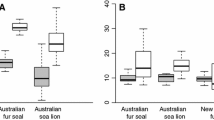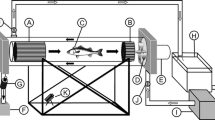Abstract
Little research has been devoted to the investigation of swimming energetics and performance in lie-in-wait predators. This study evaluated activity metabolism and swimming performance in juvenile snook, Centropomus undecimalis, a lie-in-wait predator, by determining oxygen uptake in a tunnel respirometer. Compared to previously reported results for more actively foraging species (i.e., white crappie, rainbow trout), snook exhibited lower maintenance metabolism (58.6 ml O2 kg−1 WM h−1) and greater metabolic expansibility (6.5). Relative critical swimming speeds decreased isometrically with length, implying that small snook are capable of prolonged swimming in velocity regimes similar to those experienced by larger individuals. Swimming was most efficient at the transition between pectoral (low-speed) and caudal (high-speed) propulsion. The results of this study support previous speculation that maintenance costs may be reduced in lie-in-wait predators compared to other fishes.
Similar content being viewed by others
References cited
Abud, E.O.A. 1992. Effects of salinity and weight on routine metabolism in the juvenile croaker, Micropogonias furnieri (Desmarest 1823). J. Fish Biol. 40: 471–472.
Adams, S.R. & G.R. Parsons. 1998. Laboratory-based measurements of swimming performance and related metabolic rates of field-sampled smallmouth buffalo (Ictiobus bubalus): a study of seasonal changes. Physiol. Zool. 71: 350–358.
Armstrong, J.D. 1986. Heart rate as an indicator of activity, metabolic rate, food intake and digestion in pike, Esox lucius. J. Fish Biol. 29 (Suppl. A): 207–221.
Baltz, D.M., P.B. Moyle & N.J. Knight. 1982. Competitive interactions between benthic stream fishes, riffle sculpin, Cottus gulosus, and speckled dace, Rhinichthys osculus. Can. J. Fish. Aquat. Sci. 39: 1502–1511.
Beamish, F.W.H. 1978. Swimming capacity. pp. 101–187. In: W.S. Hoar & D.J. Randall (ed.) Fish Physiology, Vol. 7, Academic Press, New York.
Beamish, F.W.H., J.C. Howlett & T.E. Medland. 1989. Impact of diet on metabolism and swimming performance in juvenile lake trout, Salvelinus namaycush. Can. J. Fish. Aquat. Sci. 46: 384–388.
Bell, W.H. & L.D.B. Terhune. 1970. Water tunnel design for fisheries research. J. Fish. Res. Board Can., Technical Report 195: 1–69.
Bernatchez, L. & J.J. Dodson. 1985. Influence of temperature and current speed on the swimming capacity of lake whitefish (Coregonus clupeaformis) and cisco (C. artedii). Can. J. Fish. Aquat. Sci. 42: 1522–1529.
Brett, J.R. 1964. The respiratory metabolism and swimming performance of young sockeye salmon. J. Fish. Res. Board Can. 21: 1183–1226.
Duthie, G.G. & D.F. Houlihan. 1982. The effect of single step and fluctuating temperature changes on the oxygen consumption of flounders, Platichthys flesus (L.): lack of temperature adaptation. J. Fish Biol. 21: 215–226.
Facey, D.E. & G.D. Grossman. 1990. The metabolic cost of maintaining position for four North American stream fishes: effects of season and velocity. Physiol. Zool. 63: 757–776.
Farlinger, S. & F.W.H. Beamish. 1977. Effects of time and velocity increments on the critical swimming speed of largemouth bass (Micropterus salmoides). Trans. Amer. Fish. Soc. 106: 436–439.
Fry, F.E.J. 1971. The effects of environmental factors on the physiology of fish. pp. 1–98. In: W.S. Hoar & D.J. Randall (ed.) Fish Physiology, Vol. 6, Academic Press, New York.
Glova, G.J. & J.E. McInerney. 1977. Critical swimming speeds of coho salmon (Oncorhynchus kisutch) fry to smolt stages in relation to salinity and temperature. J. Fish. Res. Board Can. 34: 151–154.
Johnson, L. 1966. Experimental determination of food consumption of pike, Esox lucius, for growth and maintenance. J. Fish. Res. Board Can. 23: 1495–1505.
Johnston, I.A., A. Clarke & P. Ward. 1991. Temperature and metabolic rate in sedentary fish from the Antarctic, North Sea and Indo-West Pacific Ocean. Mar. Biol. 109: 191–195.
Kolok, A.S. 1991. Photoperiod alters the critical swimming speed of juvenile largemouth bass, Micropterus salmoides, acclimated to cold water. Copeia 1991: 1085–1090.
Kreeger, K.Y. 1995. Differences in the onset of salinity tolerance between juvenile chinook salmon from two coastal Oregon river systems. Can. J. Fish. Aquat. Sci. 52: 623–630.
Lucas, M.C., I.G. Priede, J.D. Armstrong, A.N.Z. Gindy & L. De Vera. 1991. Direct measurements of metabolism, activity and feeding behaviour of pike, Esox lucius L., in the wild, by the use of heart rate telemetry. J. Fish Biol. 39: 325–345.
Moffat, R. & W. Davison. 1986. A note on the swimming performance of two species of teleost fish, the trout, Salmo trutta and the koaro, Galaxias brevipinnis. Mauri Ora 13: 71–79.
Moyle, P.B. & J.J. Cech, Jr. 2000. Fishes: an introduction to ichthyology, 4th ed. Prentice Hall, Upper Saddle River. 612 pp.
Nordlie, F.G., S.J. Walsh, D.C. Haney & T.F. Nordlie. 1991. The influence of ambient salinity on routine metabolism in the teleost Cyprinodon variegatus Lacépède. J. Fish Biol. 38: 115–122.
Parsons, G.R. & J. Carlson. 1998. Physiological and behavioral responses to hypoxia in the bonnethead shark, Sphyrna tiburo: routine swimming and respiratory regulation. Fish Physiol. Biochem. 19: 189–196.
Parsons, G.R. & J.L. Sylvester, Jr. 1992. Swimming efficiency of the white crappie, Pomoxis annularis. Copeia 1992: 1033–1038.
Pérez-Pinzón, M.A. & P.L. Lutz. 1991. Activity related cost of osmoregulation in the juvenile snook (Centropomus undecimalis). Bull. Mar. Sci. 48: 58–66.
Priede, I.G. 1985. Metabolic scope in fishes. pp. 33–64. In: P. Tytler & P. Calow (ed.) Fish Energetics: New Perspectives, The Johns Hopkins University Press, Baltimore.
Priede, I.G. & P. Tytler. 1977. Heart rate as a measure of metabolic rate in teleost fishes; Salmo gairdneri, Salmo trutta and Gadus morhua. J. Fish Biol. 10: 231–242.
Rivas, L.R. 1986. Systematic review of the perciform fishes of the genus Centropomus. Copeia 1986: 579–611.
Robinson, TW.R., R.H. Peters & J. Zimmerman. 1983. The effects of body size and temperature on metabolic rate of organisms. Can. J. Zool. 61: 281–288.
Rome, L.C., P.T. Loughna & G. Goldspink. 1985. Temperature acclimation: improved sustained swimming performance in carp at low temperatures. Science 228: 194–196.
Schmidt-Nielsen, K. 1972. Locomotion: energy cost of swimming, flying and running. Science 177: 222–228.
Smit, H., J.M. Amelink-Koustaal, J. Vijverberg & J.C. von Vaupel-Klein. 1971. Oxygen consumption and efficiency of swimming goldfish. Comp. Biochem. Physiol. 39A: 1–28.
Subrahmanyam, C.B. 1980. Oxygen consumption of estuarine fish in relation to external oxygen tension. Comp. Biochem. Physiol. 67A: 129–133.
Turnpenny, A.W.H. & R.N. Bamber. 1983. The critical swimming speed of the sand smelt (Atherina presbyter Cuvier) in relation to capture at a power station cooling water intake. J. Fish Biol. 23: 65–73.
Vetter, R.D. 1982. Seasonal metabolic compensation in sympatric seatrout: adaptation to the estuary. Trans. Amer. Fish. Soc. 111: 193–198.
Wakeman, J.M. & D.E. Wohlschlag. 1982. Least-cost swimming speeds and transportation costs in some pelagic estuarine fishes. Fish. Res. 1: 117–127.
Ware, D.M. 1978. Bioenergetics of pelagic fish: theoretical change in swimming speed and ration with body size. J. Fish. Res. Board Can. 35: 220–228.
Webb, P.W. 1975. Hydrodynamics and energetics of fish propulsion. Bull. Fish. Res. Board Can. 190. 159 pp.
Webb, P.W. 1978. Hydrodynamics: nonscombroid fish. pp. 189–237. In: W.S. Hoar & D.J. Randall (ed.) Fish Physiology, Vol. 7, Academic Press, New York.
Weihs, D. 1977. Effects of size on sustained swimming speeds of aquatic organisms. pp. 333–339. In: T.J. Pedley (ed.) Scale Effects in Animal Locomotion, Academic Press, New York.
West, G.B., J.H. Brown & B.J. Enquist. 1997. A general model for the origin of allometric scaling laws in biology. Science 276: 122–126.
Wieser, W. & N. Medgyesy. 1991. Metabolic rate and cost of growth in juvenile pike (Esox lucius L.) and perch (Perca fluviatilis L.): the use of energy budgets as indicators of environmental change. Oecologia 87: 500–505.
Author information
Authors and Affiliations
Rights and permissions
About this article
Cite this article
Gregory Tolley, S., Torres, J.J. Energetics of Swimming in Juvenile Common Snook, Centropomus undecimalis . Environmental Biology of Fishes 63, 427–433 (2002). https://doi.org/10.1023/A:1014938805181
Issue Date:
DOI: https://doi.org/10.1023/A:1014938805181




